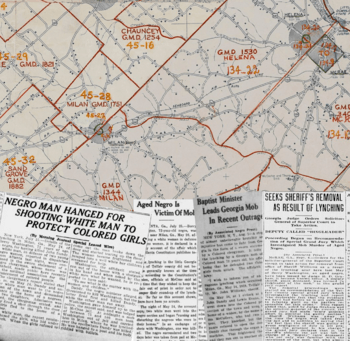Berry Washington facts for kids
Quick facts for kids
Berry Washington
|
|
|---|---|

News Coverage of Berry Washington Lynching over Milan, Georgia Map
|
|
| Born | c. 1847 |
| Died | 2:00AM May 26, 1919 (72 years old) |
| Body discovered | Milan, Georgia |
Berry Washington (born around 1847, died May 26, 1919) was a 72-year-old Black man. He was tragically killed by a mob in Milan, Georgia, in 1919. This happened after he tried to protect two young girls from harm. He was taken from jail and killed by a group of people.
The Story of Berry Washington
On May 24, 1919, two white men, John Dandy and Levi Evans, went into the Black part of Milan. They first tried to enter the home of Emma McCollers, who had two young daughters. When the family did not open the door, Dandy fired his gun.
This made the girls run to another house, the home of Emma Tisber. The two men followed them. They went into the Tisber home and tried to harm the two young Black girls. The girls tried to hide under the porch. Dandy and Evans began tearing up the floor to reach them.
Berry Washington, who was 72 years old, tried to defend the girls. He wanted the men to leave. Dandy shot at Washington. After a struggle, Washington shot and killed Dandy.
What Happened Next
Washington then went to find the chief of police, Mr. Stuckey. The chief sent Washington to the McRae jail at 2:00 AM on May 24, 1919. He stayed in jail until May 25.
At noon on May 25, a group of white men came to the jail. They were led by a Baptist minister. This group took Washington from the jail. To try and hide what they were doing, all Black residents of Milan were gathered up. They were ordered to leave the town on the night of May 25.
At 2:00 AM on May 26, the mob killed Washington. After this, white residents caused trouble in the city. They damaged and burned many Black homes. They also threatened Black citizens. They warned them not to speak about what had happened.
Seeking Justice
Local officials tried to keep the incident a secret. But a local preacher, Reverend Judson Dinkins, sent a letter. He sent it to Monroe Work at the Tuskegee Institute. Monroe Work then shared the letter with John Shillady of the NAACP.
When the Governor of Georgia, Hugh Dorsey, learned about the event, he offered a $1,000 reward. This reward was for anyone who could help arrest and convict the mob members. Dr. Floyd McRae added another $500 reward. This made the total reward $1,500.
Even though many people in the community knew who was involved, no one claimed the reward. No one was ever charged for Washington's murder.
In September 1919, it was reported that a Georgia Judge, E. D. Graham, ordered the city of McRae, Georgia to take action. He suggested that Sheriff Williams might be removed from his job because of the lynching. It was also believed that one of the sheriff's deputies was a leader in the killing.
A Time of Unrest
The killing of Berry Washington was not the only act of racial violence in Georgia in 1919. There were many other similar events. Some of these are listed below:
| Date | Place | Event | Deaths | Damage |
|---|---|---|---|---|
| February 8 | Blakeley, Georgia | Racial Violence | 4 killed | |
| April 13-15 | Jenkins County, Georgia | Racial Violence | 6 killed | 3 Black community halls and 7 Black churches burned |
| May 10 | Sylvester, Georgia | Racial Violence | 1 killed | |
| May 27–29 | Putnam County, Georgia | Fires set | 2 Black community halls and 5 Black churches burned | |
| July 6 | Dublin, Georgia | Black protection group prevents lynching | ||
| August 27-29 | Laurens County, Georgia | Racial Violence | 1 killed | 1 Black community hall and 3 Black churches burned |
These events were part of a larger period of unrest in the United States. This time is known as the American Red Summer of 1919. During this summer, there were many attacks on Black communities. White mobs attacked African American neighborhoods in over three dozen cities and counties.
In some places, Black community groups fought back against these attacks. This happened especially in Chicago and Washington D.C. Most deaths happened in rural areas. For example, in the Elaine Race Riot in Arkansas, many Black people were killed. The Chicago Race Riot and Washington D.C. race riot also caused many deaths and a lot of property damage.

